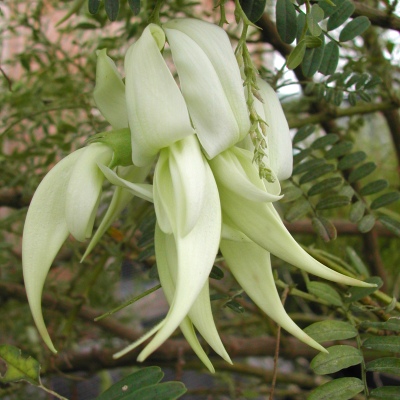White "Parrot's Beak"
Germinating the seeds Note - your seeds might have some white fluff around them. It is not mold, but rather the natural "packing material" that's produced inside the seed pod. :-) Pre-treatment -- Rub each seed lightly over sandpaper or a nail file for a few seconds to scratch the hard seed coat, so water can enter easier. Next soak the seeds in a cup of water for about 12 hours. Don't let the seeds soak for more than 24 hours. Plant them immediately after the soak. Planting the seeds -- You may
plant each seed in individual, small containers, such as seedling starter trays For soil, use a well draining
mix. I use a mix of 1 part
coir fiber Fill the pots with the soil mix, place a seed on top, cover with 1/4 inch (6 mm) of soil, and water until evenly moist. If you enclose the pots in plastic container to maintain moisture, leave it open slightly to prevent stem rot later. They germinate well between
about 65 to 77 degrees F (18-25°C). A little cooler at night is ok.
Avoid letting them get above 80° F (27°C) for prolonged periods. I recommend placing a minimum/maximum thermometer Most of the seeds should sprout within 4 to 6 weeks, although allow up to 10 weeks for any slow ones, especially at cooler temperatures. Once they sprout, give them bright light, but protect them from strong direct sun the first 2 months. For the first few months, i recommend keeping them above 55 degrees F (13°C). Growing on -- Repot to larger containers when they are 1-2 months old. Water the soil before repotting, to keep the soil ball from breaking apart, which can damage the delicate roots. For the first week after repotting, shade from sun and give no fertilizer. Fertilizing -- The first
6-8 weeks, feed every 7 days with a very dilute (1/8 strength) liquid fertilizer. Hydroponic fertilizer is ideal for this, because it is easily absorbed and contains all essential nutrients. I use General Hydroponics Flora fertilizer Climate -- It does best with temperatures above freezing, although it reportedly can take brief dips down to 22 degrees F (-5°C). If you are not in Zones 8b through 11, you may grow it in a pot and move it indoors for the winter, pruning it to any size that is convenient. It prefers mostly sunny conditions, although some afternoon shade may be needed in warmer areas. The plant is happiest below 85 degrees (29°C) and might lag in consistently hot summers with warm nights. Feel free to train the branches to grow along a fence or trellis. When the plant blooms, the flowers will dangle down, creating a spectacular effect. You may trim any branches that will block the "view" of the blooms. Pests to watch for - spider mites, mealy bugs, and slugs/snails. Try using insecticidal soap before using stronger remedies, since some may harm the plant. Have fun growing them! - Jeff Strange Wonderful Things
|
|||||||||


